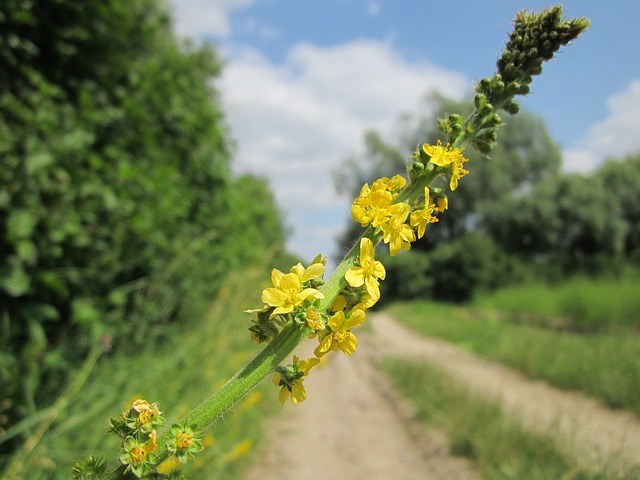 |  |  |   |   |
 |
Common Agrimony (Agrimonia eupatoria) is a perennial herbaceous plant with upright, sturdy, and hairy stems reaching heights of 30 to 100 cm. The plant is covered with rough hairs. The leaves are pinnate, dark green and velvety on the upper side, light green on the underside, arranged alternately. The lower leaves form a basal rosette. The flowers are yellow, five-petaled, regular, and arranged in long spike-like racemes up to 40 cm in length. Flowering begins in June and continues until August, during which the inflorescences elongate, new flower heads appear, and fruits ripen simultaneously.
An interesting feature of agrimony’s inflorescences is the scent of its flowers: the plant emits a pleasant aroma, which is lost when dried. In September, small fruits form—hooked achenes capable of attaching to animal fur and human clothing, enabling the plant to disperse over long distances.
Harvesting Raw Material
For medicinal purposes, the herb and roots of common agrimony are used. The aerial parts are harvested during the flowering period (June–July) by cutting leafy stems at a height of 8–10 cm above the ground. The agrimony herb is dried by hanging in bundles or spreading thinly on racks in well-ventilated rooms. A drying oven can also be used, where the raw material should be dried at a temperature not exceeding 50°C. Roots and rhizomes are dug up in autumn after the fruits have matured. They are carefully cleaned of soil, washed, and dried under a canopy in an attic or in a drying oven at a temperature not exceeding 60°C. The dried raw material can be stored for up to 2 years: the herb in paper packaging, and the roots in cloth bags or wooden containers.
It should be noted that only common agrimony (Agrimonia eupatoria) is used for medicinal purposes. Visually similar species include hairy agrimony and fragrant agrimony. To avoid confusion with the medicinal common agrimony, careful attention should be paid: the upper part of the leaves of hairy agrimony lacks hair, and its fruits have converging, conical small spines. Fragrant agrimony has glandular hairs on the stem.
Chemical Composition
The medicinal properties of common agrimony are due to its rich chemical composition. It contains a large amount of tannins, essential oils, mucilage, bitter compounds, flavonoids, mineral salts, steroidal saponins, B vitamins, vitamins C and P, resins, catechins, phytosterols, alkaloids, organic acids (malic, tartaric, citric, quinic), and sugars.
Pharmacological Properties
The galenic compounds of common agrimony exhibit astringent and diuretic effects, normalize metabolic processes, stimulate appetite, and possess hemostatic and mild choleretic properties. In vitro studies have shown that aqueous extracts of agrimony inhibit the herpes virus, while alcoholic extracts suppress the growth of α-hemolytic streptococcus and Staphylococcus aureus. The anthelmintic properties of agrimony herb have also been confirmed by European researchers.
Recent studies have identified flavonoids rutin and isoquercitrin in the plant, which stimulate lymph flow and protect blood vessels. The phytosterol content in agrimony actively inhibits cholesterol absorption in the intestines, benefiting cardiovascular function. Choline (vitamin B₄) in the plant helps synthesize the amino acid methionine, regulates blood insulin levels, and controls the transport and metabolism of fatty acids in the liver. Agrimony also demonstrates hepatoprotective, strong bactericidal, and anti-inflammatory effects.
The hemostatic activity of agrimony is attributed to its vitamin K content. Contemporary research has also revealed the plant’s potential ability to combat neoplastic growths (tumors).
Use in Traditional Medicine
Cosmetic Uses
The herb of common agrimony has tonic, anti-inflammatory, and rejuvenating effects. It is included in many cosmetic products for facial and body skin care, such as skin gels, balms, and creams. Agrimony-based shampoos for damaged hair effectively soften the hair, give it a natural shine, and strengthen the roots.
